Make a picture transparent
Basic steps to picture transparency
In short, the steps for making a picture transparent are:
Draw a shape first, fill it with a picture, and then adjust the picture's transparency.
This process is demonstrated in the video. For more details on this procedure and other methods, click a procedure heading below to expand it and see the details.

Detailed steps for transparency
Make the whole picture transparent
-
Select Insert > Shapes. Choose a shape from the gallery that opens.
-
Draw the shape in your document, making it the same proportions as the picture you're about to add to it.
-
Select the shape. Click Format > Shape Outline > No Outline.
-
Right-click the shape again, and then click Format Shape.
-
In the Format Shape pane, click the Fill icon
 , and then click Picture or texture fill.
, and then click Picture or texture fill.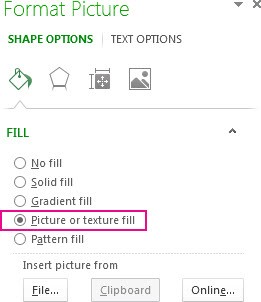
-
Click the File button. In the Insert Picture dialog box, locate the picture file that you want to insert. Select the picture and then select the Insert button.
-
Move the Transparency slider in the Format Shape pane to adjust the picture.
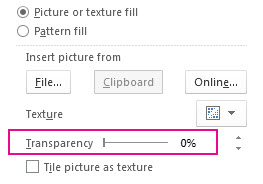
Or you may enter a number in the box next to the slider: 0 is fully opaque, the default setting; and 100% is fully transparent.
If you change the original size ratio of your shape by dragging it, the picture you insert into the shape may be skewed. Also, some pictures may not fit perfectly into certain shapes. You can make adjustments to the appearance of your picture by resizing your shape or by using the Offset settings below the transparency slider.
Note: If you're using PowerPoint, you can make a picture transparent and use it as a slide background.
Make part of a picture transparent
You can make one color in a picture transparent by using the built-in transparency feature.
Unlike making an entire picture transparent, making only one color transparent is possible only in an object that's inserted as a picture, not inside a shape. If your picture is inserted in a shape as fill, as described above, the Set Transparent Color option is not available.
Important: Areas that seem to be a single color (for example, green leaves) might actually be made up of a range of subtle color variations, and you might not get the effect you want. Setting a transparent color works best with simple, solid-color pictures, such as clip art.
-
Double-click the picture, and when Picture Tools appears, click Picture Tools Format > Color.
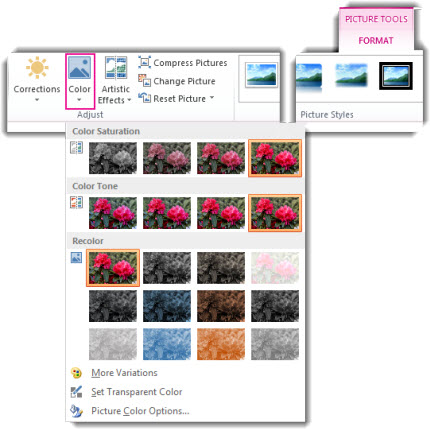
-
Click Set Transparent Color, and when the pointer changes, click the color you want to make transparent.
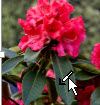
In the picture below, the leaves are composed of several colors of green, so only part of the leaves are made transparent, which makes it difficult to see the transparent effect. Repeating the process with a different color will remove the transparency from the first color. To undo color changes, click Reset Picture in the Adjust group.

Note: When you print pictures with transparent areas, the transparent areas are the same color as the paper. On your screen or a website, the transparent areas are the same color as the background.
Make a picture watermark
See the instructions in Add a background watermark to slides.
Make a shape transparent
-
Select Insert > Shapes.
-
Select a shape from the drop-down gallery and then draw it the size that you want.
-
Right-click the shape and choose Format Shape.
The Format Shape panel opens.
-
In the panel, open the Fill section.
-
Select the Transparency slider and drag rightward to set the degree of transparency you want.
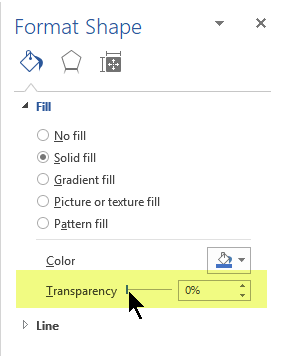
Remove the background of a picture
Make the picture transparent outside of Office
If you have an image editing app, you can use it to make your picture transparent. Then save the picture in a format that preserves transparency information (such as a Portable Network Graphics (.png) file), and insert the file into your Office document.
Vote for a simpler way
If you'd like to be able to make a picture transparent without having to use a shape, please go to our suggestion box and vote for it to let the PowerPoint product team know.
Basic steps to picture transparency
In short, the process for making a picture transparent is:
Draw a shape first, fill it with a picture, and then adjust the picture's transparency.
This process is demonstrated in the video. For more details on this procedure and other methods, click a procedure heading below to expand it and see the details.

Detailed steps for transparency
Make the whole picture transparent
Draw a shape first, fill it with a picture, and then adjust the picture's transparency:
-
Select Insert > Shapes. Choose a shape from the gallery that opens.
-
Draw the shape in your document, making it the same proportions as the picture you're about to add to it.
-
Select the shape. Click Format > Shape Outline > No Outline.
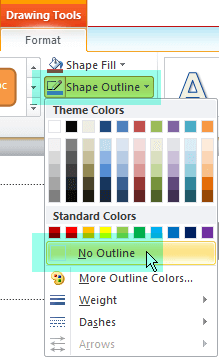
-
Right-click the shape again and select Format Shape.
-
In the Format Shape dialog box, under Fill, select Picture or texture fill, then select File.

-
In the Insert Picture dialog box, find your picture, select it, and then select Insert.
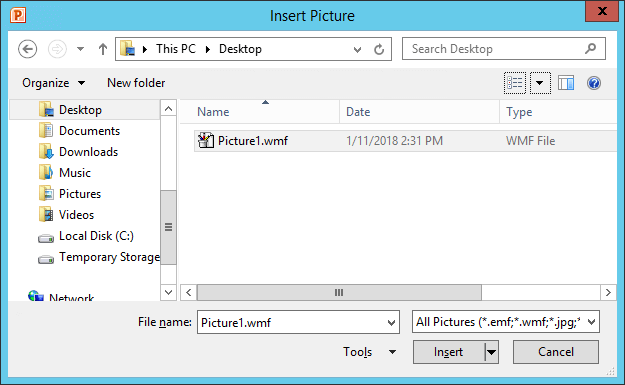
The picture is added to slide, inside the shape. You may need to move the Format Picture dialog box to see it. Keep the dialog box open to adjust the transparency.
-
With the picture now showing inside the shape, in the Format Picture dialog box, move the Transparency slider rightward (or enter a number in the box next to the slider) to adjust the picture as you see fit.
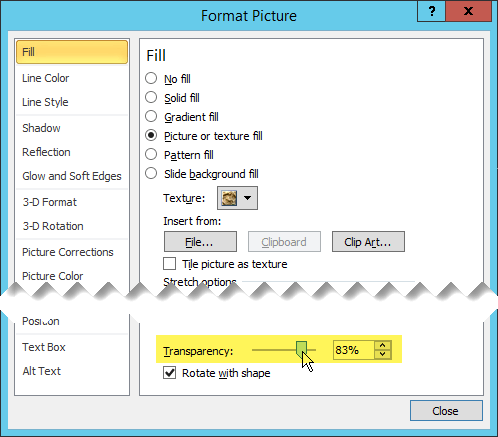
You can vary the percentage of transparency from 0 (fully opaque, the default setting) to 100% (fully transparent).
-
Select Close to dismiss the dialog box.
Tip: If you change the original size ratio of your shape by dragging it, the picture you insert into the shape may be skewed. Also, some pictures may not fit perfectly into certain shapes. You can make adjustments to the appearance of your picture by resizing your shape or by using the Offset settings above the transparency slider.
Make part of a picture transparent
You can make one color in a picture transparent by using the built-in transparency feature.
Unlike making an entire picture transparent, making only one color transparent is possible only in an object that's inserted as a picture, not inside a shape. If your picture is inserted in a shape as fill, as described above, the Set Transparent Color option is not available.
Important: Areas that seem to be a single color (for example, green leaves) might actually be made up of a range of subtle color variations, and you might not get the effect you want. Setting a transparent color works best with simple, solid-color pictures, such as clip art.
-
Double-click the picture, and when Picture Tools appears, click Picture Tools Format > Color.

-
Click Set Transparent Color, and when the pointer changes, click the color you want to make transparent.

In the picture below, the leaves are composed of several colors of green, so only part of the leaves are made transparent, which makes it difficult to see the transparent effect. Repeating the process with a different color will remove the transparency from the first color. To undo color changes, click Reset Picture in the Adjust group.

Note: When you print pictures with transparent areas, the transparent areas are the same color as the paper. On your screen or a website, the transparent areas are the same color as the background.
Make a picture watermark
See the instructions in Add a background watermark to slides.
Make a shape transparent
-
Select Insert > Shapes.
-
Select a shape from the drop-down gallery and then draw it the size that you want.
-
Right-click the shape and choose Format Shape.
The Format Shape dialog box opens.
-
In the dialog box, in the Fill section, select the Transparency slider and drag rightward to set the degree of transparency you want.
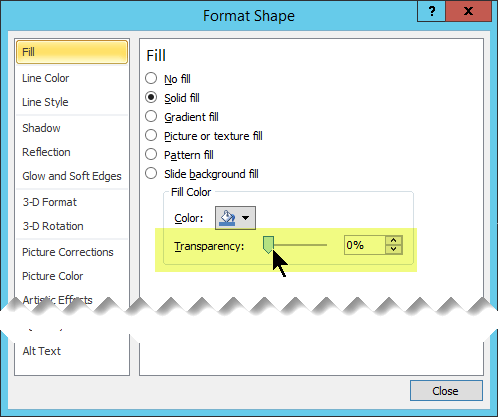
Remove the background of a picture
Make the picture transparent outside of Office 2010
If you have an image editing app, you can use it to make your picture transparent. Then save the picture in a format that preserves transparency information (such as a Portable Network Graphics (.png) file), and insert the file into your Office document.
Basic steps to picture transparency
In short, the steps for making a picture transparent are:
-
Draw a shape first
-
Fill it with a picture
-
Adjust the picture's transparency
Detailed steps for transparency
Make the whole picture transparent
Insert a picture, inside a shape, at the precise size you want, and then adjust its transparency:
-
Select Insert > Shapes. Choose a shape from the gallery that opens.
-
Draw the shape in your document, making it the same proportions as the picture you're about to add to it.
-
Select the shape. Click Format > Shape Outline > No Outline.
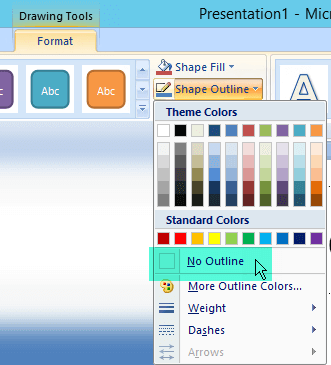
-
Right-click the shape and select Format Shape.
-
In the The Format Shape dialog box, under Fill, select Picture or texture fill, then select File.
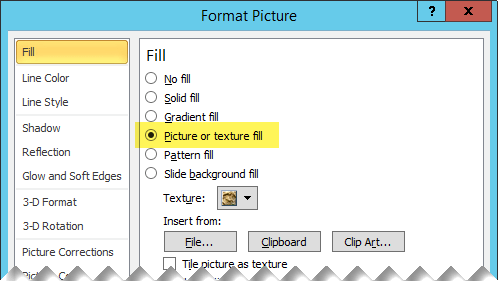
-
In the Insert Picture dialog box, locate the picture that you want, select it, and then select Insert.
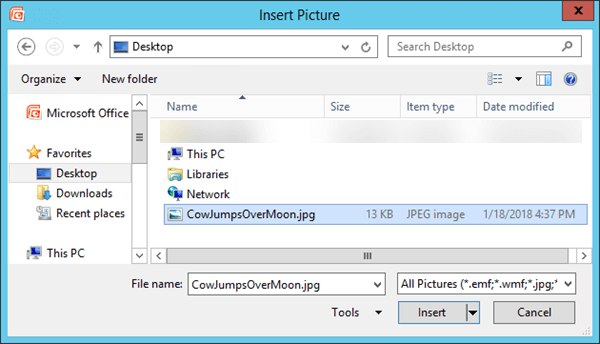
The picture is added to slide, inside the shape. You may need to move the Format Picture dialog box to see it. Keep the dialog box open to adjust the transparency.
-
With the picture now showing inside the shape, in the Format Picture dialog box, move the Transparency slider rightward (or enter a number in the box next to the slider) to adjust the picture as you see fit.
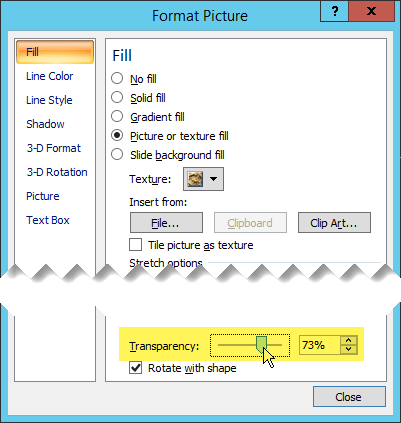
You can vary the percentage of transparency from 0 (fully opaque, the default setting) to 100% (fully transparent).
-
Select Close to dismiss the dialog box.
Make part of a picture transparent
You can make one color in a picture transparent by using the built-in transparency feature.
Important: Areas that seem to be a single color (for example, green leaves) might actually be made up of a range of subtle color variations, and you might not get the effect you want. Setting a transparent color works best with simple, solid-color pictures, such as clip art.
-
Click the picture that you want to create transparent areas in.
-
Under Picture Tools, on the Format tab, in the Adjust group, click Recolor.

-
Click Set Transparent Color, and then click the color in the picture or image that you want to make transparent.
Notes:
-
The Set Transparent Color option is available for bitmap pictures that are not already transparent, and some clip art.
-
You cannot create a transparent area in animated GIF pictures. You can, however, make transparency changes in an animated-GIF editing program, and then re-insert the file into your 2007 Microsoft Office system document.
-
You can make more than one color transparent in a picture in another image editing program, save the picture in a format that preserves transparency information (such as a Portable Network Graphics (.png) file), and then insert the file into your 2007 Office release document.
-
Make a picture watermark
See the instructions in Add a background watermark to slides.
Make a shape transparent
-
Select Insert > Shapes.
-
Select a shape from the drop-down gallery and then draw it the size that you want.
-
Right-click the shape and choose Format Shape.
The Format Shape dialog box opens.
-
In the dialog box, in the Fill section, select the Transparency slider and drag rightward to set the degree of transparency you want.
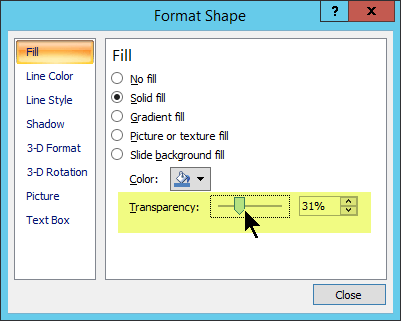
Make the picture transparent outside of Office 2007
If you have an image editing app, you can use it to make your picture transparent. Then save the picture in a format that preserves transparency information (such as a Portable Network Graphics (.png) file), and insert the file into your Office document.
Change the transparency of a picture or fill color
-
Select the picture or object for which you want to change the transparency.
-
Select the Picture Format or Shape Format tab, and then select Transparency
 .
.A gallery of preset transparency options for the picture appears.
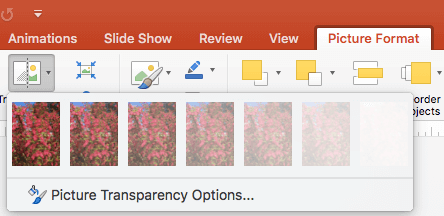
-
Select one of the preset options, or select Picture Transparency Options at the bottom for more detailed choices.
The Format Picture pane opens on the right side.
-
Under Picture Transparency, drag the transparency slider rightward to set the exact percentage of transparency you want, or set a percentage value in the box.
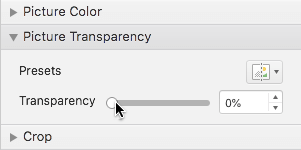
You can vary the percentage of transparency from 0 (fully opaque, the default setting) to 100% (fully transparent).
Make part of a picture transparent
You can make one color in a picture transparent to hide part of the picture or create a layered effect. Transparent areas in pictures are the same color as the paper on which they are printed. In an electronic display, such as a web page, transparent areas are the same color as the background.
-
Select the picture for which you want to change the transparency of a color.
-
On the Picture Format tab, select Color, and then select Set Transparent Color.
-
Click the color in the picture or image that you want to make transparent.
Note: You can't make more than one color in a picture transparent. Areas that appear to be a single color (for example, blue sky) might actually be made up of a range of subtle color variations. Therefore, the color that you select might appear in only a small area, and it might be difficult to see the transparent effect in certain pictures.
Change the transparency of a picture or fill color
-
Select the picture or object for which you want to change the transparency.
-
Select the Format Picture or Format tab.
-
Drag the Transparency slider (circled in green int he picture below) rightward to set the exact percentage of transparency you want.

Make part of a picture transparent
You can make one color in a picture transparent to hide part of the picture or create a layered effect. Transparent areas in pictures are the same color as the paper on which they are printed. In an electronic display, such as a web page, transparent areas are the same color as the background.
-
Select the picture for which you want to change the transparency of a color.
-
On the Format Picture tab, click Recolor, and then select Set Transparent Color.
-
Click the color in the picture or image that you want to make transparent.
Note: You can't make more than one color in a picture transparent. Areas that appear to be a single color (for example, blue sky) might actually be made up of a range of subtle color variations. Therefore, the color that you select might appear in only a small area, and it might be difficult to see the transparent effect in certain pictures.
You can't make a picture transparent in Office Online. You have to use a desktop version of Office (on either Windows or macOS) instead.
See Also
Add a background or watermark to slides
Remove the background of a picture
You actually make it seem so easy with your presentation but I find this matter to be actually something that I think I would never understand. It seems too complex and extremely broad for me. I am looking forward for your next post, I will try to get the hang of it! app entwickeln lassen berlin
ReplyDeleteMicrosoft Office Tutorials: Make A Picture Transparent >>>>> Download Now
ReplyDelete>>>>> Download Full
Microsoft Office Tutorials: Make A Picture Transparent >>>>> Download LINK
>>>>> Download Now
Microsoft Office Tutorials: Make A Picture Transparent >>>>> Download Full
>>>>> Download LINK LZ
Microsoft Office Tutorials: Make A Picture Transparent >>>>> Download Now
ReplyDelete>>>>> Download Full
Microsoft Office Tutorials: Make A Picture Transparent >>>>> Download LINK
>>>>> Download Now
Microsoft Office Tutorials: Make A Picture Transparent >>>>> Download Full
>>>>> Download LINK fW